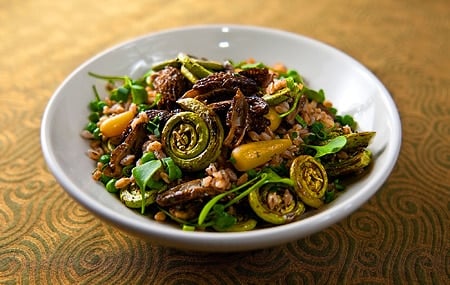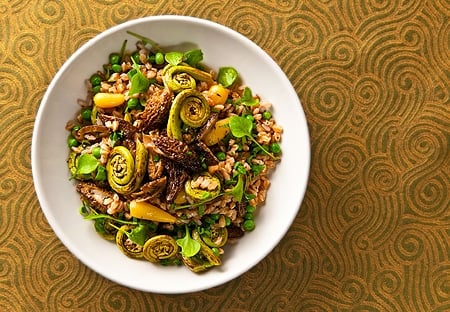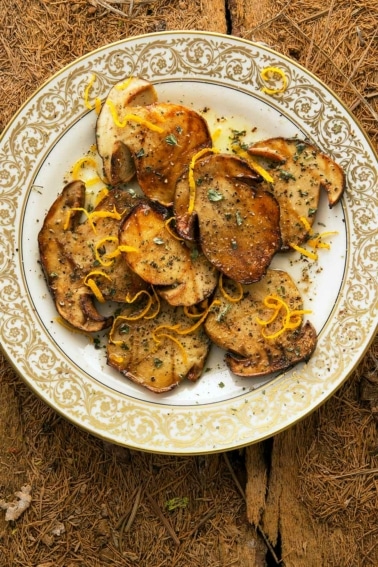As an Amazon Associate I earn from qualifying purchases.

To paraphrase from Oscar Wilde, the education of a mushroom hunter is rarely pure, and never simple.
I managed to find my first morels of the season last weekend and it was a worthy haul, enough for a couple nice meals. I was pretty confident we’d find them, too, which is unusual for me. This was a new place, pointed out to us by the Sacramento Area Mushroomers, one of whose members had spotted morels in the area earlier in the week. That sent the alarm bell ringing within the group, and we gathered in Yuba County, at about 2,500 feet (more I will not say), in search of the spring’s finest edible mushroom.
The “we” in my group was not the usual “we.” Holly was ill and reluctantly had to skip the trip, but someone who follows me on Twitter asked if he could come along. I hemmed and hawed, but when it became clear he would likely be searching in a similar place, I said sure, come on. And as serendipity would have it, he wound up right behind me on the highway. Over breakfast we introduced ourselves. His name is Danny, and he works for a tech firm in the Bay Area. Turns out he’s a really nice guy.
It also put me in the teacher’s role. Danny is a good mushroom hunter, just not for morels. I am a good mushroom hunter, but am only slightly better with morels. My advantage is that I’ve found them in the Sierra Nevada before, and I know what it ought to look like when they are around.
Morels are spring mushrooms. They pop as early as January or February in the Deep South, and Georgia has an excellent early season. The flush spreads out of the Southeast, and can be epic in the eastern part of the Midwest: Illinois, Indiana and Ohio can be some of the best places for morels in the country. Out here in the Pacific, our morels come late — unless you’re talking about “mulch morels,” whose spores lie dormant in store-bought mulch until March or so. Mostly we hit the Sierra Nevada starting in late April and work our way up the mountainside until June.
In fact, my special morel spot will not be popping for another month to six weeks, making these some of the latest morels in the lower 48 states.
Morels need high temperatures somewhere around 60 degrees, and lows somewhere around 40 degrees to pop. They tend to hang around trees, but a flush can spread from a particular tree for a long way. Where we hunt them, morels like to live with a pretty orange cup fungus; it’s some species of peziza.

As you can see, morels also like conifers. Especially burnt conifers. We get a special morel in the Pacific that only really pops after a forest fire. This is why I was pretty confident we’d find morels: We were able to comb over an area that burned last year.
I admit I was nervous. This was a new spot, and I really, really wanted to put Danny on some mushrooms; if any of you are fishing or hunting guides out there, I know how you feel. I also wanted to find enough for dinner. It was pretty warm out, so I started looking in shady places that I reckoned might get some sun at some part of the day — everywhere but the south faces of slopes.

Bingo. Not 15 minutes into the hunt, I spotted a morel.
Morels don’t like to be by themselves, so I dropped to my haunches and let my eyes unfocus a little. I was looking for patterns. Sure enough, just behind the first morel was a second. And then another. And another.
“Found some!” I told Danny. That’s when mushrooming etiquette kicked in. Without any words, Danny knew to work the edges of my “claim,” and not rush in next to me. He Who Finds the Morels gets the center of the flush.
Danny, sadly, did not find any morels where he looked. But now that I had a dozen or so, I felt better about my own abilities, so I started looking with him to see if we could find another spot.
Funny how mushrooms can be. I was sure I’d picked my little flush clean. So we walked around a bit, but found nothing. “Let’s go back around that first flush,” I suggested, hoping I’d missed some on the edges. Danny went right back to where I’d been picking — maybe eight feet to the right of it, actually — and practically squealed: “Oooh! Found one! Wait… wait… found a ton!” I kneeled down, and Danny was surrounded by big, beautiful morels. Schweet! These were the first morels he’d ever found, after two years of searching. Believe me, Danny, I know exactly how you feel.
Each laden with a small sack of morels, the day could basically end there if we wanted to. So we went exploring, trying to get a sense of where the flush was. Danny found another small patch of morels nestled against a fallen log, on the sunny side. Some of the mushrooms were smaller than the last digit on his little finger. That pretty much sealed it: We were early.

That means there’s a chance that spot will produce again in a few days. So, like General MacArthur, we shall return.
I managed to come home with about 40 morels, close to 12 ounces. Definitely enough for a couple meals. One was this warm salad, which has pretty much everything that’s wonderful about spring in it: Fiddleheads, pickled ramps, farro, peas, miner’s lettuce and yes, morels.
Morel Salad with Fiddleheads
Ingredients
- 4-6 ounces fresh morel mushrooms
- 8 ounces fiddleheads or asparagus tips
- Salt
- 1 cup farro or barley
- 1 quart vegetable broth
- 4 tablespoons olive oil, divided
- 1 cup peas
- 2 tablespoons minced green garlic, or 1 large clove of regular garlic
- 1/2 cup pickled ramp bulbs, or the white parts of spring onions
- 1 cup miner's lettuce, or baby spinach
Instructions
- Slice the morels in half lengthwise and drop them into a bowl of cool water. Swish them around a little, then let them float while the debris trapped in them sinks. Some debris will also float, however, so carefully pick out the mushrooms and put them on a tea towel to dry.
- Bring a pot of water to a boil and add enough salt to make it taste like the sea. Clean your fiddleheads and boil them 5 minutes, then drop them into a bowl of clean ice water. Once they are cool, move them to the tea towel next to the morels to dry. Don't mix them because you will cook each ingredient separately.
- Bring the broth to a boil and add the farro. Add salt to taste and simmer this gently -- you want the broth to just barely be bubbling -- until the farro is tender. Drain the farro and put it into a large bowl with the peas, which will cook with the residual heat of the grain. Mix in 2 tablespoons of olive oil.
- Heat a large saute pan over high heat for 2 minutes. Add the morels and shake the pan so they don't all stick immediately. Shaking the pan, let the morels sizzle and give up their water, about 2 minutes. Add the remaining olive oil and toss to combine. Saute the morels for 2 minutes. Add the fiddleheads and sprinkle salt over everything in the pan. Saute 2 more minutes.
- Add the morels and fiddleheads to the bowl with the farro, then add the pickled ramps and green garlic. Stir in the miner's lettuce or baby spinach. Serve hot or at room temperature.
Notes
Nutrition
Nutrition information is automatically calculated, so should only be used as an approximation.





So good! Just made it and am enjoying it now. Didn’t soak the green onions in vinegar (though I will next time) – but added some tomatoes, and that has given a bit of a tang… Also added a bit of parsley, and cooked to farro in chicken broth for a little added depth.
The salad is gorgeous and looks great-tasting. I also love the background tablecloth (or is it wrapping paper?) Holly and/or you chose for the final shot. Fiddleheads on fiddleheads 🙂
That Morel salad look amazing! The season is right around the corner! 🙂
Oh. I am jealous. So jealous. I haven’t had a good morel hunt in years. Small patches here and there, they are so hit and miss. Granted, I wouldn’t know where to start in Alberta. Manitoba? I can pull over at the side of the road and find them thanks to most of my mushroom learning happening there. Alberta so far has skunked me for anything more than a potful.
wow north faces high altitudes already. in southern Oregon i am still on the lower south faces. Having fun!
This is making me so hungry for what we called sponge mushrooms. Used to hunt them as a kid with my dad. One year we found a bunch in the area where we burned trash–no trees in sight. Never did figure that one out.
we found our first ones this weekend {eastern WA}…can’t wait to go out and look for more
JR: I wish! That’s the day before I leave for my big road trip. My morel season will be as short as yours. 🙁
Charade: yes, you can collect your own fiddlheads. You need to find Lady Ferns in the West, and Ostrich Ferns in the East. You’ll have to go to the coast or high in the mountains for Western fiddleheads now. Easterns are just coming on.
Patricio: It is indeed! One of the great joys of eating wild food.
Jason: I hear elm trees a lot in the East. I know people who are still getting them on north faces high in the Appalachians right now…
Russell: Yep. In fact, my other good spot might still be good when I get back from book tour in June. Things are THAT late.
Matt: Keep looking! You’ll find them.
Tamar: Yeah, Massachusetts in general is not really morel country. I’ve found chanterelles on Cape Ann in the summer, though…
Debbie: Thanks for the correction on the cup fungus. Always another mushroom to learn. 😉
Lynne: Maybe morels ARE gnomes! Could explain why they’re so meaty…
That certainly rings in spring here at 4,200 feet, though here in eastern Oregon we’re still a few weeks behind.
I love your note about “looking for patterns,” since that is the only way I ever find them. I think it no coincidence that morels are shaped like gnomes’ hats, because I think they can magically disappear the moment you try looking too hard for them. They’re tricky!
Deja vu! That burn has been making folks happy for several weeks now (we just finished the last of our haul this past week)…but at only 2,200′ and with rising temperatures, it is a time-limited offer…as you know, the mountain morels have been slow to appear this year, but with this hot weather, the fruitings will start crawling up those mountain slopes….
I am really writing to correct your orange cup fungus ID…not a “Peziza” but a Geopyxis carbonaria, stalked and distinctive with that pale, scalloped edge and burn site habitat. Gotta love those springtime ascos! 😉
Debbie Viess
Bay Area Mycological Society
Nice! Morels have been as scarce as hen’s teeth this year. Good to hear that you were able to find some. Thanks for sharing the great recipe (and the shoutout)!
Now that is a beautiful thing. I’ve never in my life found a morel, and I’ve been told that Cape Cod isn’t good for them — the few that are here are of the mulch variety. So I’ll admire yours, and wait to see if my hen-of-the-wood tree comes through for me again this year.
Just went morel hunting for the first time here in Central Ohio. Despite weeks of very wet conditions, we managed to find a few in an area rumored to have them.
Our haul was a tasting portion at best, though. I envy your find!
Wow, now that’s a Spring meal!
Last Sunday the weather was fantastic so we went out on an epic survey of the usual suspects up here in WA. A 300 mile loop across the Cascades to the Leavenworth area, down Blewett Pass to Cle Elum, and back across to Seattle. All the places we’ve found them before had nothing. It’s been a cold Spring, but it was dry, mostly snow free, and my guess is they’ll start popping up by this weekend and really get going next week. Last year I found about 75 morels and 6lbs of Spring Kings at one spot in mid-late May, so it’s still a little early here.
Jealous. Our season’s long over, and I only got out once. Everyone’s notes on which trees are preferred seem to get tossed out the window with each new find… My ol’ reliable patches on a mountain in SW VA are not attached to any one kind of tree as far as I can tell.
Nice!! Must be a great satisfaction to come home, hands full, and cook them nicely right then and there…
Cheers!
Beautiful. Love your site!
What a great post! I’m glad you found such a great flush, and that you were kind enough to share. I’m a recent convert to your blog, so forgive me if you’ve covered this already: Can you collect your own fiddleheads for this fabulous-sounding salad, or do you always buy them at the market?
Nice work, sounds like they are in the range which I expected. The spot my wife and I go to (3,500 – 4,000) usually pops now, but appears to be delayed. We my try and hit it next weekend, but are leaving for Italy on Sunday. We may miss morels this year. I don’t have a higher range staked out, but maybe we need to explore a bit when we get back.
I’ll keep you posted if we decided to day trip it next Saturday if you are free.